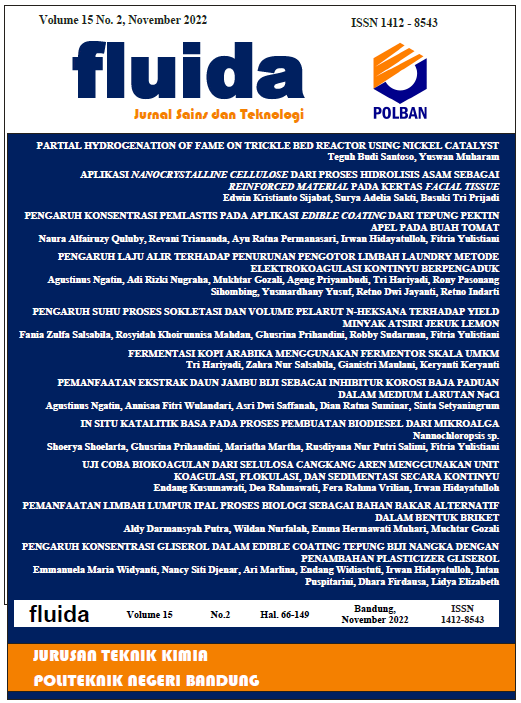Fermentasi Kopi Arabika Menggunakan Fermentor Skala UMKM
Main Article Content
Abstract
Coffee farmer in Babakan Kertasari Village requires a fermenter that can ferment 100 kg of coffee cherries per day to fulfill the market demand. Therefore, the object of this study is to make a coffee fermenter with SMEs scale and to evaluate the performance of the fermenter with the addition of 130 ml/L of Local Microorganism (MOL) made from fermented cassava (cassava tape). Fermentation was carried out for 72 hours in room temperature and in semi-aerobic condition with 14 kg of coffee cherries in SMEs scale fermenter. Evaluation of the fermenter performance was done by analysing pH and ethanol content and organoleptic test of taste and aroma of fermented coffee. The result of analysis shows that fermented Arabica coffee which called cultured coffee fulfilled the National Indonesian Standard (SNI) with pH greater than 4 and caffeine content of 1.97%. Organoleptic test showed that 56% of panellists really like the aroma and 24% of panellists really like the taste of cultured coffee.
Downloads
Article Details

This work is licensed under a Creative Commons Attribution-ShareAlike 4.0 International License.
An author who publishes in the FLUIDA journal agrees to the following terms:
- Author retains the copyright and grants the journal the right of first publication of the work simultaneously licensed under the Creative Commons Attribution-ShareAlike 4.0 License that allows others to share the work with an acknowledgement of the work's authorship and initial publication in this journal
- Author is able to enter into separate, additional contractual arrangements for the non-exclusive distribution of the journal's published version of the work (e.g., post it to an institutional repository or publish it in a book) with the acknowledgement of its initial publication in this journal.
- Author is permitted and encouraged to post his/her work online (e.g., in institutional repositories or on their website) prior to and during the submission process, as it can lead to productive exchanges, as well as earlier and greater citation of the published work (See The Effect of Open Access).
Read more about the Creative Commons Attribution-ShareAlike 4.0 Licence here: https://creativecommons.org/licenses/by-sa/4.0/.
References
[2] Permentan No. 52. 2012.
[3] C. F. Silva, L. R. Batista, L. M. Abreu, E. S. Dias, dan R. F. Schwan, “Succession of bacterial and fungal communities during natural coffee (Coffea arabica) fermentation,” Food Microbiology, vol. 25, no. 8, hlm. 951–957, Des 2008, doi: 10.1016/j.fm.2008.07.003.
[4] G. Sakwari, S. H. D. Mamuya, M. Bråtveit, L. Larsson, C. Pehrson, dan B. E. Moen, “Personal exposure to dust and endotoxin in Robusta and Arabica coffee processing factories in Tanzania,” Annals of Occupational Hygiene, vol. 57, no. 2, hlm. 173–183, Mar 2013, doi: 10.1093/annhyg/mes064.
[5] Yusianto dan S. Widyotomo, “Mutu dan Citarasa Kopi Arabika Hasil Beberapa Perlakuan Fermentasi: Suhu, Jenis Wadah, dan Penambahan Agens Fermentasi Quality and Flavor Profiles of Arabica Coffee Processed by Some Fermentation Treatments: Temperature, Containers, and Fermentation Agents Addition,” 2013.
[6] A. F. Aini dan Saripah, “Fermentasi Biji Kopi Arabika Menggunakan Fermentor Sederhana untuk Menghasilkan Kopi Wine,” Tugas Akhir Diploma Tiga, Politeknik Negeri Bandung, 2021.
[7] R. Rismayani dan S. Nurjanah, “Fermentasi Biji Kopi Arabika menggunakan Mikroorganisme Lokal (MOL) Tapai Singkong,” Tugas Akhir Program Diploma Tiga, Politeknik Negeri Bandung, Bandung, 2020.
[8] Ridwansyah, “Ridwansyah, 2003,” 2003.
[9] M. A. Hidayat, “FERMENTASI ASAM LAKTAT OLEH Rhizopus oryzae PADA SUBSTRAT SINGKONG HASIL HIDROLISIS ASAM,” 2006.
[10] T. Graves, N. v. Narendranath, K. Dawson, dan R. Power, “Effect of pH and lactic or acetic acid on ethanol productivity by Saccharomyces cerevisiae in corn mash,” Journal of Industrial Microbiology and Biotechnology, vol. 33, no. 6, hlm. 469–474, Jun 2006, doi: 10.1007/s10295-006-0091-6.
[11] M. A. N. Amuntoda, “PERBANDINGAN KADAR ALKOHOL DAN UJI ORGANOLEPTIK WINE KOPI ARABIKA (Coffea arabica) TEMANGGUNG VARIETAS KARTIKA YANG DIHASILKAN MELALUI METODE EKSTRAKSI COLD BREW DAN MASERASI MENGGUNAKAN STRAIN YEAST POLANDIA (Saccharomyces cereviceae),” Skripsi, Universitas Sanata Dharma, 2018.
[12] A. A. T. Wilujeng dan P. R. Wikandari, “PENGARUH LAMA FERMENTASI KOPI ARABIKA (Coffea arabica) DENGAN BAKTERI ASAM LAKTAT Lactobacillus plantarum B1765 TERHADAP MUTU PRODUK THE EFFECT OF FERMENTATION TIME OF ARABICA COFFEE (Coffea arabica) WITH Lactobacillus plantarum B1765 LACTIC ACID BACTERIA TO THE PRODUCT QUALITIES,” 2013.
[13] C. Mukiyat dan S. Yenti, “Pembuatan Bioetanol dari Nira Nipah Menggunakan Sacharomyces cereviceae,” 2013.
[14] L. Ilze dan Z. Kruma, “Influence of the roasting process on bioactive compounds and aroma profile in specialty coffee: a review,” Mei 2019, hlm. 7–12. doi: 10.22616/FoodBalt.2019.002.
[15] N. Asiah, M. Aqil, N. S. Dwiranti, W. David, dan A. Ardiansyah, “Sensory and Chemical Changes of Cold and Hot Brew Arabica Coffee at Various Resting Time,” Asia Pacific Journal of Sustainable Agriculture, Food and Energy, vol. 7, no. 2, Des 2019, doi: 10.36782/apjsafe.v7i2.1948.
[16] N. Salmaa Dwiranti, A. Ardiansyah, dan N. Asiah, “Sensory Attributes of Cold Brew Coffee Products at Various Resting Time After Roasting Process,” Pelita Perkebunan (a Coffee and Cocoa Research Journal), vol. 35, no. 1, hlm. 42–50, Apr 2019, doi: 10.22302/iccri.jur.pelitaperkebunan.v35i1.349.

